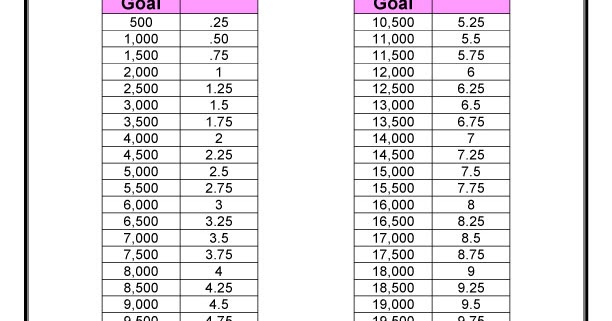The Concept of Measuring Walking Distance
Understanding how many steps equal a mile is crucial for individuals striving to maintain an active lifestyle and track their physical activities. By accurately measuring the number of steps taken during a walk or run, one can effectively monitor their progress, set fitness goals, and evaluate their overall performance. This information is particularly valuable for those who prefer walking or running as their primary mode of exercise or transportation.
Understanding the Variability in Step Length
Step length, which refers to the distance covered by one full step, varies among individuals due to factors such as height, stride style, and walking speed. Taller individuals typically have longer step lengths, while shorter individuals have shorter step lengths. Stride style, or the pattern of foot movement during walking, also influences step length. For instance, individuals who take longer, slower strides usually have a longer step length compared to those who take shorter, quicker steps.
Walking speed is another critical factor affecting step length. Generally, faster walking speeds result in longer step lengths, while slower walking speeds lead to shorter step lengths. Therefore, understanding one’s step length and how it relates to their personal fitness goals is essential for accurate conversion between steps and miles.
How to Measure Your Step Length
To determine your unique step length, you can use either manual measurement techniques or smart devices and apps. Here are the steps for both methods:
Manual Measurement Technique
1. Choose a flat, measured surface, such as a track or a hallway with marked distances. 2. Walk naturally along the measured surface, ensuring that you maintain a steady pace. 3. Measure the distance covered by 20 steps, adding the lengths of each step together. 4. Divide the total distance by 20 to find your average step length.
Smart Device or App Measurement Technique
1. Use a smart device or app that includes a step length measurement feature. 2. Follow the device or app’s instructions for measuring step length, which typically involves walking a certain distance while the device or app calculates your step length based on its accelerometer data. 3. Ensure that you maintain a steady pace and walk naturally during the measurement process. 4. Review the calculated step length, which should be displayed on the device or app.
Regardless of the method used, it is essential to measure step length under conditions that mimic your regular walking pattern to ensure accurate conversion between steps and miles.
Calculating Steps per Mile Based on Step Length
Once you have determined your step length, you can calculate the number of steps required to cover a specific distance, such as a mile. The formula for calculating steps per mile is:
Steps per Mile = 5280 ÷ Step Length
In this formula, 5280 represents the number of feet in a mile. By dividing 5280 by your step length (in feet), you can calculate the approximate number of steps required to cover a mile.
For example, if your step length is 2.5 feet, you can calculate the number of steps per mile as follows:
Steps per Mile = 5280 ÷ 2.5 = 2112 Steps
This calculation indicates that, with a step length of 2.5 feet, you would need approximately 2112 steps to cover a mile. Keep in mind that individual step lengths may vary slightly during different activities or due to changes in walking speed, so it is essential to recalculate your steps per mile periodically to maintain accuracy.
Typical Step Counts for Various Distances
To help you better understand the relationship between step counts and various distances, we have compiled a table of typical step counts for distances ranging from a quarter mile to several miles. Keep in mind that individual step lengths may vary, so these numbers should be used as a general guideline:
| Distance | Typical Step Count |
|---|---|
| Quarter Mile | 250-350 Steps |
| Half Mile | 550-800 Steps |
| Three-Quarter Mile | 850-1200 Steps |
| One Mile | 2000-2500 Steps |
| Two Miles | 4000-5000 Steps |
| Three Miles | 6000-7500 Steps |
| Four Miles | 8000-10000 Steps |
By using this table as a reference, you can better estimate the number of steps required to cover various distances and track your progress during walking, running, or hiking activities.
Using Pedometers and Fitness Trackers for Step Counting
Pedometers and fitness trackers are popular devices for monitoring step counts and distance traveled during physical activities. These tools can help you track your progress, set fitness goals, and stay motivated. Here, we will discuss the benefits of using pedometers and fitness trackers, compare different types of devices, and provide recommendations for choosing the right device based on individual needs and preferences.
Benefits of Pedometers and Fitness Trackers
Pedometers and fitness trackers offer several benefits, including:
- Accurate step counting and distance tracking
- Motivation and accountability for meeting fitness goals
- Integration with smartphones and other devices for easy data access
- Monitoring of heart rate, sleep patterns, and other health metrics
Types of Devices
There are several types of pedometers and fitness trackers available, including:
- Basic pedometers: Simple devices that count steps and estimate distance
- Advanced pedometers: Devices with additional features, such as calorie tracking and stair climbing counters
- Fitness trackers: Devices that monitor various health metrics, including heart rate, sleep patterns, and steps
- Smartwatches: Wearable devices that combine fitness tracking with smartphone notifications and other features
Choosing the Right Device
When selecting a pedometer or fitness tracker, consider the following factors:
- Accuracy: Look for devices with high accuracy in step counting and distance tracking
- Features: Determine which features are most important to you, such as heart rate monitoring, sleep tracking, or water resistance
- Comfort: Choose a device that is comfortable to wear, with adjustable straps or bands
- Battery Life: Consider devices with long battery life, especially if you plan to use them for extended periods without recharging
- Compatibility: Ensure that the device is compatible with your smartphone or other devices
- Price: Set a budget and compare devices within your price range
By considering these factors, you can find a pedometer or fitness tracker that meets your needs and helps you accurately track your step counts and distance traveled.
Incorporating Step Count Goals into Fitness Programs
Setting step count goals can be a valuable addition to your fitness program, whether you’re walking, running, or hiking. By tracking your progress and working towards specific goals, you can stay motivated, improve your fitness level, and enhance your overall health. Here, we will discuss how to set realistic step count goals, track your progress, and adjust your goals based on individual fitness levels and objectives.
Setting Realistic Step Count Goals
To set realistic step count goals, consider the following:
- Assess your current fitness level: Determine your starting point by measuring your typical daily step count. This will help you establish a baseline and set achievable goals.
- Consider your objectives: Are you looking to improve your overall health, lose weight, or train for a specific event? Your goals will influence the number of steps you aim to achieve each day.
- Gradually increase your step count: Start with a modest increase in steps, then gradually build up over time. Aim for a weekly increase of no more than 10% to avoid injury and maintain consistency.
Tracking Progress
To track your progress, use a pedometer or fitness tracker to monitor your daily step count. Record your daily steps and periodically review your progress to ensure you’re moving towards your goals. You can also use apps or online platforms to log your steps and visualize your progress over time.
Adjusting Goals
Regularly assess your progress and adjust your step count goals as needed. If you find that your goals are too easy or too challenging, make adjustments accordingly. Remember to maintain a balance between pushing yourself and avoiding burnout or injury. Additionally, be prepared to modify your goals based on changes in your fitness level, health status, or lifestyle.
Incorporating step count goals into your fitness program can be a rewarding and engaging way to enhance your physical activity and overall health. By setting realistic goals, tracking your progress, and making adjustments as needed, you can create a customized fitness plan that meets your unique needs and objectives.
Additional Considerations for Step Counting and Distance Tracking
When tracking steps and converting them to distance, there are several additional factors to consider to ensure accuracy and consistency in your measurements. Here, we will discuss the impact of terrain, incline, and walking style on step length and step count, as well as the importance of consistency in step counting and the value of regular calibration.
Terrain, Incline, and Walking Style
The surface you walk on, the incline of your path, and your walking style can all influence your step length and step count. For example, walking on softer surfaces, such as sand or grass, may result in shorter step lengths and a lower step count compared to walking on harder surfaces, like concrete or asphalt. Similarly, walking uphill can increase your step length and step count, while walking downhill may decrease both. Your walking style, such as heel striking or midfoot striking, can also affect your step length and step count.
Consistency in Step Counting
Maintaining consistency in your step counting method is crucial for accurate tracking and comparison of your physical activity over time. Choose a device or method that suits your needs and preferences, and stick with it to minimize variability in your measurements. If you switch devices or methods, be aware that there may be discrepancies in your step counts and adjust your expectations accordingly.
Regular Calibration
Regularly calibrating your pedometer or fitness tracker can help ensure accurate step counting and distance tracking. Calibration involves measuring your step length and entering it into your device’s settings. Some devices may automatically calibrate, while others may require manual calibration. Check your device’s user manual for specific instructions on calibration and follow the manufacturer’s recommendations to maintain accuracy.
By considering these additional factors, you can enhance the accuracy and consistency of your step counting and distance tracking, ultimately providing valuable insights into your physical activity and progress towards your fitness goals.









